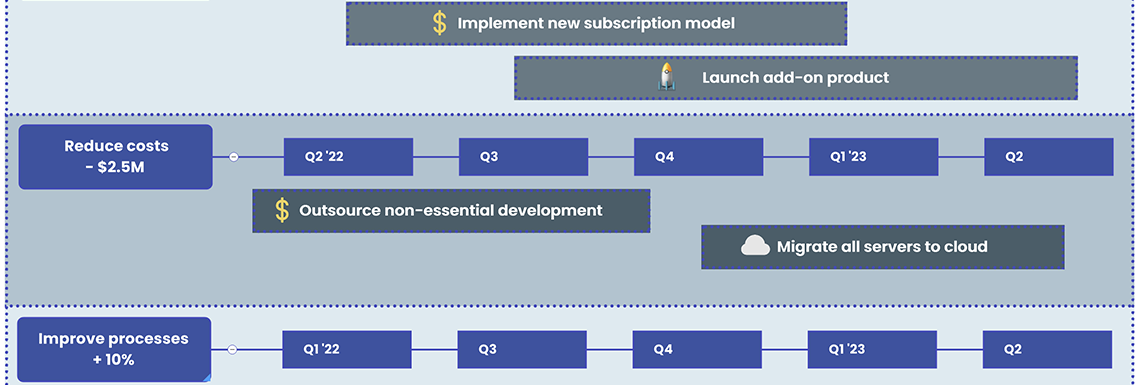At the most basic level, a product roadmap is a visual representation of a product strategy. As a plan of action and path toward execution, product roadmaps are valuable strategic tools that answer the basic questions of what will be done, and by when.
Designing or developing a product roadmap starts with determining what your end goal(s) are for your product or version release, and then working backward to figure out the steps required to get there.
There are many types of product roadmaps, each suited for different products, workflows, teams, and stakeholders.
A product roadmap can be used to document key tasks, deliverables, and milestones for a particular product launch, or serve as a centralized project management tool to help your team work together more effectively throughout the product development and launch process. It can also be a helpful way to periodically communicate progress and provide status updates to stakeholders.
The difference between a product roadmap vs. a product plan
While many of the same elements can appear in both a product roadmap and a product plan, there are key differences between the two.
A product plan is a document (or collection of documents) that clarifies what the product is, who it is for, and why it is being developed. It serves as a centralized focus for your product vision, direction, and priorities.
A product roadmap serves as a path to product execution and eventual delivery or launch. It’s a visualization of the product strategy that outlines what tasks will be completed by which resources or teams, and when these steps will be accomplished.
Product roadmaps typically feature key milestones and are meant to align stakeholders and team members with a clear direction, scope, and goals. They’re often more flexible than project plans since the execution and final features of a given product can be a moving target.
Common types of product roadmaps
Some of the most commonly used product roadmap types include stakeholder-driven roadmaps, focus-driven roadmaps, and outcome- oriented roadmaps. Let’s take a closer look at each.
Stakeholder-driven roadmaps are designed to communicate the proposed path forward for key stakeholders, and tend to deliver a bird’s eye view of the product. Examples of these types of roadmaps include:
- Executive roadmaps, which are designed to provide proof of concept and encourage buy-in from the C-suite and investors.
- Sales team and customer roadmaps, which are meant to provoke excitement and provide details on upcoming releases for the sales and customer support teams.
- Product portfolio roadmaps, which encompass all planned product releases within a single view.
Focus-driven roadmaps address a certain area of convergence or target for the product at hand. Examples of these types of roadmaps include:
- Strategy roadmaps, which define your overall product strategy.
- Market roadmaps, which address the larger ecosystem or market space that your product will exist within.
- Technology roadmaps, which show how your product fits into long-term goals.
- Product release and product feature roadmaps, which identify the release schedule and features to be included at each stage of your product’s development.
Orientation-driven roadmaps focus on a key area or areas of product development and production. Examples of these types of roadmaps include:
- Outcome-oriented roadmaps, which cover the problems you are trying to solve with the new product.
- Status-oriented roadmaps, which provide status updates on a product or release at a given moment in time.
- Time-oriented roadmaps, which provide a timeline or timeframes for the product development process and the various milestones along the way.
Key benefits of visual product roadmaps
Using visual diagrams or other visualizations as part of your product roadmap process can help team members better understand their role in a given project.
Key benefits of using visual product roadmaps include:
- Enhanced strategic alignment amongst product goals, customer goals, and organizational goals.
- Increased team-wide clarity on product vision and desired outcomes.
- Sharpened focus due to shared understanding of goals and target results.
- Improved communication because visual roadmaps are a concise collaborative tool that enable team members to quickly grasp product concepts and their tasks or roles in the development process.
The above benefits can also lead to richer, more involved buy-in from key stakeholders, since they will be able to better understand your product goals, expected outcomes, and the path to success.
Discover how to create your own visual product roadmaps in our step-by-step e-book.

Learn more about the benefits of visual product roadmaps in the next article in this series.

